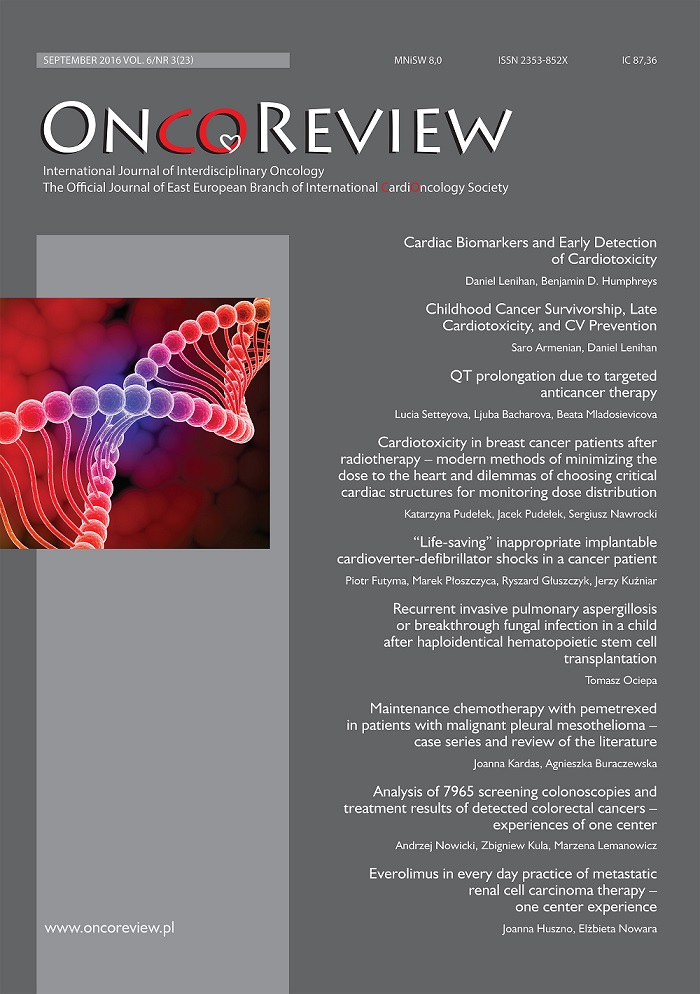Cardiotoxicity in breast cancer patients after radiotherapy – modern methods of minimizing the dose to the heart and dilemmas of choosing critical cardiac structures for monitoring dose distribution Review article
Main Article Content
Abstract
Radiotherapy in breast cancer patients is an important component of multidisciplinary treatment. It reduces the risk of local recurrence and mortality from breast cancer. However, it can lead to secondary effects due to the presence of the heart within the irradiation field. Adjuvant radiation therapy for breast cancer increases the risk of coronary artery disease, myocardial infarction and cardiovascular death. It is important to determine the optimal treatment to minimize cardiotoxicity. Modern radiotherapy techniques may reduce radiation-induced cardiac toxicity, but it is necessary to determine the most sensitive structures within the heart, tolerance doses, and methods for early detection and monitoring of adverse effects.
Downloads
Metrics
Article Details

This work is licensed under a Creative Commons Attribution-NonCommercial 4.0 International License.
Copyright: © Medical Education sp. z o.o. This is an Open Access article distributed under the terms of the Attribution-NonCommercial 4.0 International (CC BY-NC 4.0). License (https://creativecommons.org/licenses/by-nc/4.0/), allowing third parties to copy and redistribute the material in any medium or format and to remix, transform, and build upon the material, provided the original work is properly cited and states its license.
Address reprint requests to: Medical Education, Marcin Kuźma (marcin.kuzma@mededu.pl)
References
2. Yeboa DN, Evans SB. Contemporary Breast Radiotherapy and Cardiac Toxicity. Semin Radiat Oncol 2016; 26(1): 71-78.
3. Raj KA, Evans ES, Prosnitz RG et al. Is there an increased risk of local recurrence under the heart block in patients with left-sided breast cancer? Cancer J 2006; 12: 309-317.
4. Canney PA, Sanderson R, Deehan C et al. Variation in the probability of cardiac complications with radiation technique in early breast cancer. Br J Radiol 2001; 74: 262-265.
5. Formenti SC, DeWyngaert JK, Jozsef G et al. Prone vs supine positioning for breast cancer radiotherapy. J Am Med Assoc 2012; 308: 861-863.
6. Lu HM, Cash E, Chen MH et al. Reduction of cardiac volume in left-breast treatment fields by respiratory maneuvers: a CT study. Int J Radiat Oncol Biol Phys 2000; 47: 895-904.
7. Korreman SS, Pedersen AN, NØttrup TJ et al. Breathing adapted radiotherapy for breast cancer: Comparison of free breathing gating with the breath-hold technique. Radiother Oncol 2005; 76: 311-318.
8. Mast ME, van Kempen-Harteveld L, Heijenbrok MW et al. Left-sided breast cancer radiotherapy with and without breath-hold: does IMRT reduce the cardiac dose even further? Radiother Oncol 2013; 108: 248-253.
9. Hiatt JR, Evans SB, Price LL et al. Dose-modeling study to compare external beam techniques from protocol NSABP B-39/RTOG 0413 for patients with highly unfavorable cardiac anatomy. Int J Radiat Oncol Biol Phys 2006; 65: 1368-1374.
10. Senkus E, Kyriakides S, Ohno S et al. Primary breast cancer: Esmo Clinical Practice Guidelines for diagnosis, treatment and follow-up. Ann Oncol 2015; 26(suppl 5): v8-v30.
11. Lin LL, Vennarini S, Dimofte A et al. Proton beam versus photon beam dose to the heart and left anterior descending artery for left-sided breast cancer. Acta Oncol 2015; 54(7): 1032-1039.
12. Evans SB, Panigrahi B, Northrup V et al. Analysis of coronary artery dosimetry in the 3-dimensional era: Implications for organ-at-risk segmentation and dose tolerances in left-sided tangential breast radiation. Pract Radiat Oncol 2013; 3: e55-e60.
13. Lee YC, Chuang JP, Hsieh PC et al. A higher incidence rate of acute coronary syndrome following radiation therapy in patients with breast cancer and a history of coronary artery diseases. Breast Cancer Res Treat 2015; 152(2): 429-435.
14. Boekel NB, Schaapveld M, Gietema JA et al. Cardiovascular Disease Risk in a Large, Population-Based Cohort of Breast Cancer Survivors. Int J Radiat Oncol Biol Phys 2016; 94(5): 1061-1072.
15. Taylor CW, Wang Z, Macaulay E et al. Exposure of the Heart in Breast Cancer Radiation Therapy: A Systematic Review of Heart Doses Published During 2003 to 2013. Int J Radiat Oncol Biol Phys 2015; 93(4): 845-853.
16. McGale P, Taylor C, Darby S. Cardiotoxicity of radiotherapy in breast cancer patients. OncoReview 2015; 5(2): 14-17.
17. McGale P, Darby SC, Hall P et al. Incidence of heart disease in 35000 women treated with radiotherapy for breast cancer in Denmark and Sweden. Radiother Oncol 2011; 100(2): 167-175.
18. Tariq H, Harrison EE. Cardiovascular concerns from radiation therapy and other radiation exposure. OncoReview 2016; 6(2): 91-92.
19. Nitsche M, Pahl R, Huber K et al. Cardiac Toxicity after Radiotherapy for Breast Cancer: Myths and Facts. Breast Care (Basel) 2015; 10(2): 131-135.
20. Kingsley PA, Negi P. Radiation induced cardiotoxicity in left sided breast cancer – Where do we stand? Chrismed. J of Health Res 2015; 2(1): 8-13.
21. Bovelli D, Plataniotis G, Roila F; ESMO Guidelines Working Group. Cardiotoxicity of chemotherapeutic agents and radiotherapy-related heart disease: Esmo Clinical Practice Guidelines. Ann Oncol 2010; 21(suppl 5): v277-282.
22. Taylor CW, Povall JM, McGale P et al. Cardiac dose from tangential breast cancer radiotherapy in the year 2006. Int J Radiat Oncol Biol Phys 2008; 72; 5001-5007.
23. Jacob S, Pathak A, Franck D et al. Early detection and prediction of cardiotoxicity after radiation therapy for breast cancer: the BACCARAT prospective cohort study. Radiat Oncol 2016; 11(1): 54.

